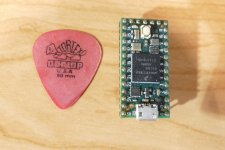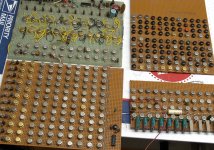That's interesting. One possible solution would be to make the idle frequency a real note, somewhere in the middle of...the acquisition time it takes to capture a note above / below that setting. Kinda like how they parked the heads in old disk drives in the middle of the platter, so they wouldnt have to sweep all the way from one end to get to some data track.Tracking the frequency of each string is not quite as simple since each string can span up to two octaves. Experiments with CMOS PLL chips reveal the main issue. A tracking PLL will revert to an idle frequency in the absence of an input. It will take a finite time to lock onto the freshly picked note during which its output must be muted. Low frequency transients from some heavy picking on the strings will push the PLL lower in frequency making the acquisition time random and occasionally long enough for the mute time to be audible.
Imagining some compression and band limiting on the input to the PLL would go a long way to homogenize the signal one expects it to track. That should do in the Low frequency transients from picking.
I never refined my PLL based "G-synth" to hex pickups where the PLL could enjoy just an octave above/below it's idle frequency. I did explore voltage controlled "Q", where the bandwidth went wide with input level, while at the same time the filter followed the frequency of the PLL, "Q" narrowing as the guitar string signal decayed. All that as pre-processing to the comparitor generating the square wave signal for the PLL.
Well it was fun messing with all that; only the ideas remain in my head. As I mentioned and you also, it's hard to get something that makes better than noise. Oh, I could get it to track, glide between notes, but getting it to do all that in a musical way was one of those things where I just couldnt get it to cooperate seemingly no matter what. I spent far too long on the sample and hold part which worked maybe 1 out of 3 times; not holding just sharp or flat. With that dream of infinite sustain.
Alan Holdsworth played a Synthaxe which I believe had constant fret distance. It was amazing to hear him play unison on guitar and that instrument, knowing one had normal fret spacing, the other constant fret spacing.The physical means a normal guitar uses to achieve those notes is irrelevant to an electronic instrument.
My short fat fingers don't work reliably above fret #18 or 19 depending on which guitar I'm playing so I set the idle frequency of each PLL at about fret #10's frequency. My early experimentation used MC14046 PLL chips which are good to about 500 KHz on regulated 5 volts obtained from a NiCad battery pack from an RC car. I ran the PLL somewhere in the 100+ KHz range so that I could use a divider chain after the loop to get adjustable harmonic levels. Think drawbars on a Hammond organ. That PLL could acquire lock from one direction faster than the other, and messing with the loop filter to even it up often resulted in some wild overshoot and ringing which did sound rather cool.That's interesting. One possible solution would be to make the idle frequency a real note, somewhere in the middle of...the acquisition time it takes to capture a note above / below that setting. Kinda like how they parked the heads in old disk drives in the middle of the platter, so they wouldnt have to sweep all the way from one end to get to some data track.
Given that fact that you must fret a string a few mS before plucking it one can read the starting pitch from the fret - string electrical contact and send that info to the PLL system. The last 12 years of my engineering career were spent in a research group that "defined the state of the art in high performance RF transceivers." We had some really fast PLLs capable of jumping 10% of its frequency range in microseconds. The main trick was the use of two loop filters or two loops. The fast or "adapt" loop would get the PLL close really fast then the "active" loop would take control. This could be applied to a PLL in either the analog or digital domain.
Small, cheap single board 32 bit computers that run at near 1GHz have become commonplace since I last played with a wired guitar neck. I'm sure a lot of new ideas will pop up when I get back to it. This 32 bit bad boy runs at 600 MHz and can be overclocked to almost 1 GHz. I have one running three polyphonic MIDI synthesizers simultaneously. It should be able to run a guitar.........
Attachments
In my opinion, it is the modelling /mimicking of the actual string instrument that makes the electronic one "playable" using the existing skills of musicians.The physical means a normal guitar uses to achieve those notes is irrelevant to an electronic instrument.
For example, generating a control voltage (for a VCO) using the linear ribbon would give different finger / fret positions along the board, that might require musicians to "re-learn" things before the instrument could even be used (musically), also possibly causing difficulties with testing etc.
In my opinion, an instrument is just a dumb scientific device whose job is to "obey" the artisitically intelligent musician who "plays" by deciding the pitch and temperament of its sound, according to his/her musical preferences.The frequency of a note will be hard coded in software, probably a "tempered scale" according to the well-defined standard scales.
However, I'm still very grateful to the members who participated in this thread, as it certainly helped to "induce" a lot of ideas in my head.
I did something similar with the 4046 at the time; I managed to put an mk50240 - a fun little functional bloc chip - in between the 4046 oscillator and the phase comparitor. That allow me to play in one musical key and have it come out in a different key. The EE instrumentation elective prof liked that. The drawbars idea didnt occur to me at the time, probably something to do with having zero experience with a Hammond organ. I played endlessly with that loop filter, remembering and implementing the old diode circuit from an envelope generator to give different up/down loop acquisition times, so I was somewhat able to balance out the up/down time difference. The two switched loops idea never occurred to me.I ran the PLL somewhere in the 100+ KHz range so that I could use a divider chain after the loop to get adjustable harmonic levels. Think drawbars on a Hammond organ.
Musically, the cap-charging-through-resistor exponential acquisition meant for long glissandos, the stupid thing never quite "got there" in tune in a musically playable way. That was the base effect I wanted also, to have it sound like a synth player is attempting to play in unison with the guitarist. It did occur to me that perhaps if I used a bipolar current source to drive the loop filter, the the acquisition ramps would be linear and perhaps that issue would be solved.
God knows what that would do to the behavior of the PLL; for all I know it being able to capture at all depends on that exponential nature. I never got around to designing a current source that would behave the same way as the output of Phase Comparitor II, going tri-state and all when in-lock. 40 plus years later, I still think of it occasionally.
Let me guess. In a software based PLL, you can make the "loop" part behave any way you want, regarding how the oscillator sweeps toward the next target frequency.
I stumbled onto some video where John McLaughlin was moseying around a NAMM show and he stopped briefly by someone's guitar synth display. They were elated and immediately setup their device to record anything he did with it. He maybe played 10 notes, put it down and said "pretty good". I believe that which you said was exactly what he was looking for, if he'd have to modify his playing style in any way to make their synth work. These days that is the goal; the musician plays as they ordinarily do, the synth tracks it in a musical way successfully.that might require musicians to "re-learn" things before the instrument could even be used (musically),
I guess that Google must be spying on us 🙂
I just turned on my PC, opened YouTube and this 12 year old video was suggested to me. Coincidence? I think not.
I just turned on my PC, opened YouTube and this 12 year old video was suggested to me. Coincidence? I think not.
You must have used the older CD4046. There is the newer 74HC/HCT9046A with a better VCO and a charge-pump based loop filter (like you mention). The charging / discharging current is set by a resistor, with no resistor required for the loop filter anymore. Note that most pins (except 1 and 15) are the same as in the 4046.Musically, the cap-charging-through-resistor exponential acquisition meant for long glissandos, the stupid thing never quite "got there" in tune in a musically playable way. ... It did occur to me that perhaps if I used a bipolar current source to drive the loop filter, the the acquisition ramps would be linear and perhaps that issue would be solved.
I get that all the time, that's just the way Youtube works, they try really hard to keep you hooked.I guess that Google must be spying on us 🙂
After seeing your posts mentioning lasers / laser diodes, I'm trying to think if the inexpensive hardware inside an optical mouse (plentiful) could somehow be modified to replace ribbons.
Yes, all of my early experiments used old Motorola branded CMOS chips since I had, and still have a bunch from my DIY synthesizer experiments in the 70's. I still have some of the DIY synthesizer boards I made in the late 60's and early 70's that used RTL (resistor-transistor logic before TTL or CMOS was made). Each round package contains a single gate or flip flop. It takes a lot of chips to do anything useful. The latest date code on a part is from 1970. Most were from 67 through 69. The green board is a "top octave generator" like the MK5024 or MK50240.You must have used the older CD4046. There is the newer 74HC/HCT9046A with a better VCO and a charge-pump based loop filter
Today we can simply use an Arduino to spit bits into a DDS chip like the AD9832 oved SPI or I2C. Yes, they are fast enough to track a pitch bend or glissando. Unfortunately, the DIP packaged parts have gone away. The Teensy boards are supported by an "audio library" that incorporates several methods of audio generation or playback. I have made three complete synths with a box of pots and a Teensy board.
By the mid 70's I made enough money to simply buy a Univox branded Mini Korg (before Korg was the brand name) followed by a sick ARP Odyssey that I fixed and expanded into a mess of DIY stuff.
I get that all the time, that's just the way Youtube works, they try really hard to keep you hooked.
Youtube does keep record of every video you watch while logged in. In my case this is over 15 years of videos. They try to put something in front of you that's related to what you watch. Similar to Amazon's targeted adverts, the algorithm breaks down when my ADHD powered brain wanders off in random unrelated directions sometimes for hours watching stuff that I have never watched before. One of my grandkids posts video game related stuff on YouTube. If I watch one of his videos I get bombed with gaming stuff for a week or two. I build PC's for myself and others. Watching a video about a new CPU chip, Windows trick, or other non game subject gets me a bunch of game videos that I never watch. I'm sure that these are cleverly disguised adverts or attempts to boost viewing of that genre.
Now the real mystery is how does an advert for Mercedes Benz automobiles pop up on my phone whenever I drive by the Mercedes Benz dealership that's about 50 miles away from my home near Pittsburgh? I did buy the first phone from Amazon and cloned the second phone from it. Amazon is another major data miner like Google, Apple, Microsoft, and Ebay. Obviously these guys don't know what kind of vehicles we drive, though Amazon should since I have ordered several repair parts for the 2012 Honda Pilot from them.
Attachments
Oooooh! As I was doing this in the late 70's, it was likely the old version. That certainly piques the curiosity.The charging / discharging current is set by a resistor, with no resistor required for the loop filter anymore.
Well, it should be comforting to know that your ideas were rather ahead of your time, as such improvements to the 4046/A namely, the 7046A and 9046A came out only in the 1990s. However, they're still manufactured (and consumed) to this day.
I think the touch-based sliders need a lot of chips or alternatively a chip with a lot of pins (e.g. FPGA), to get excellent resolution. Still wondering what the OP did with electronic switches.
I think the touch-based sliders need a lot of chips or alternatively a chip with a lot of pins (e.g. FPGA), to get excellent resolution. Still wondering what the OP did with electronic switches.
Last edited:
Well, after looking at the different "inexpensive" methods for the "touch" interface, I now feel that it may not be that bad an idea to use actual strings !!
Hi newvirus2008,
Yes I am.
I apologize for for being tardy.
I will definitely have some info by the end of the week.
All of the components of the instrument have been stored in various places in my house. It took me a while to find them all.
Sincerely,
Ralf
Yes I am.
I apologize for for being tardy.
I will definitely have some info by the end of the week.
All of the components of the instrument have been stored in various places in my house. It took me a while to find them all.
Sincerely,
Ralf
I've been reading on synthesiser techniques over the past week and now I think I understand what you say here. It seems what I had in mind earlier (when I said trigonometric in #14) is called 'subtractive synthesis'. The one you mention appears to be the superior method called 'wavetable synthesis' that uses a real waveform template and then the add attack / decay / sustain / release (ADSR) aspects, according to inputs from the user. The wavetable method also appears to be more flexible in that it may very well use multiple reference waveforms for different occasions for example, to model the the tonal variations between the low and high strings.When I say a "touch" interface, I don't mean the waveform. That comes from a wave table, and you probably want a number of options. No, I'm talking about the plucking attack and decay rates, and the "keyboard debounce" that decides when a "string" has been plucked, and maybe what is called "velocity" in an electronic keyboard.
To the O.P. Please PM price location and contact info. I may buy your electronics. I own a Shober Recital Organ, 250 lb, with a dead D# master oscillator board. I believe the oscillator coil is at fault.I am an organ player, but my working Hammond H-182 organ only has 25 pedals, whereas most churches have a 32 pedal AGO board. The Shober recital organ also has different sounds than a Hammond.
I thought of doing pitch bend effects for guitar parts using lasar distance finder transducer. I cannot play actual guitar; my skin is too soft to grow the calluses required to play without pain. I learned 6 or 8 chords for 2 years, but I could not graduate from nylon to wire strings. My fingernails also fracture when I try to pluck strings with them. As the kids in the choir grew up, I could not play wire guitar over their louder voices. The upside, no wrinkles on my face until my late sixties.
I thought of doing pitch bend effects for guitar parts using lasar distance finder transducer. I cannot play actual guitar; my skin is too soft to grow the calluses required to play without pain. I learned 6 or 8 chords for 2 years, but I could not graduate from nylon to wire strings. My fingernails also fracture when I try to pluck strings with them. As the kids in the choir grew up, I could not play wire guitar over their louder voices. The upside, no wrinkles on my face until my late sixties.
Last edited:
Sounds like me... I play nylon, as it's easier in one dimension at least. Still, after many years, I cannot get a solid sounding B, Bb, Bm... I actually have to rephrase the music to accommodate how long it takes for my fingers to wrap around and come down on that Bm.I learned 6 or 8 chords for 2 years, but I could not graduate from nylon to wire strings.
I started out on an electric guitar at age 7. It was something cheap and, I could not play it very well due to "lack of strength in my fingers." When my mother dragged me to a different guitar teacher he tried my guitar, muttered a few obscenities, then ripped all the strings off the guitar and restrung it. It was the moment that I first realized that I could actually play a guitar. He took off the "telephone cables" and installed some light gauge strings. He said that I should use the light gauge strings until I got good enough to go up to a heavier gauge string. That was about 65 years ago and I still use light gauge strings. The box of Ernie Ball Super Slinky strings I just got from Amazon are .009 .011 .016 .024 .032 and .042. There is an even lighter gauge available, but I have not tried them. These are the same strings I have used since my mid 20's which was the peak of my guitar playing abilities.I cannot play actual guitar; my skin is too soft to grow the calluses required to play without pain. I learned 6 or 8 chords for 2 years, but I could not graduate from nylon to wire strings. My fingernails also fracture when I try to pluck strings with them.
I have a "Lyon by Washburn" acoustic guitar that I found at a flea market for $30. I like the tone but find it hard to play. The strings range from .011 to .052. Several lighter string sets are available, so I'll probably try one of the .009 to .046 sets to see if it makes a difference.
A lighter gauge string is easier to fret because it is thinner, but also because it requires less tension to reach the same pitch as a thicker string. Large changes in string gauge may require a truss rod adjustment since the total stress on the neck will change.
Last edited:
Hello everyone,
I have been fascinated by the Guitar since I was a teenager.
Many years later, when I was an employee at Scully Recording Instruments Co, Inc. , a fellow employee and I had a discussion about guitars, when he brought up the possibility of a stringless electronic guitar. At that time neither one of us had any idea as to how to construct such an instrument.
Soon thereafter I visited the US patent office in Washington, DC and to my surprise found quite a number of patents of just such instruments. As none of them appealed to me, I set out to design my own version of a stringless electronic Guitar. I did not know enough about electronics to design my own music producing electronic circuits and decided to purchase the music producing circuit boards of a Schober Theater Organ in kit form. The intent was to house the organ components in an external transportable console as they would never fit into the body of a guitar.
The next step was to design the circuitry that would go into the body of the guitar itself. I knew, that would require a very large guitar body and the largest guitar I was aware of in the mid seventies was the large 12-string Guild model that John Denver played. So, I purchased a guitar case for that model and reverse engineered the body and neck dimensions from it.
Then I realized that, I needed some form of touch sensitive switch for the fingerboard and one of my colleagues at Scully's suggested that I could turn a transistor on and off by connecting a power source to the base of a transistor with my finger. That worked. I then created a fingerboard that incorporated 24 touch switches, two octaves. Then I decided to make the fret spacing a uniform .800 inches with strips of abalone inlayed where the frets would have been. I also made the sides of the neck / fingerboard parallel to each other as a tapered neck / fingerboard is only needed as the frets get closer together near to the body of the guitar. There are 144 (24x6) transistors under the fingerboard.
The guitar was to incorporate an electronic capo, and because being electronic, and it can't be seen, I place 11 red light emitting diodes into the side of the fingerboard to indicate where the capo was located. And since I wanted the guitar to be a switchable right and left hand instrument, I placed another 11 LEDs into the other side of the fingerboard.
I machined the neck of the guitar from a billet of 6061-T6 aluminum on a Bridgeport vertical milling machine. The underside of the neck is shaped like half of an ellipse which I machined with a ball end mill by placing the neck fingerboard side down on the machine table lined up with its X axis. I then draw filed and polished the neck and had it anodized and dyed black.
Finally, when I saw how ugly a guitar neck without a headstock looks, I designed and built a headstock consisting of two book-matched pieces of walnut with maple binding and herring bone inlays front and back. I also inlayed abalone "strings" into the headstock and finally attached some mock tuning machines.
The first picture shows the touch switch test with equally spaced flush "frets"
The two parallel "wires" are connected to the base of a transistor and a source of power (5VDC if I remember correctly)
The second picture shows the complete neck. The two Cannon connectors connect three strings each to the body electronics. These connectors are reversible to turn the instrument from right-hand playable to left-hand playable. The single Amphenol connector connects the LEDs to the body.
The third picture shows the fingerboard removed from the neck and placed upside down. It contains 144 transistors.
The fourth picture shows the back of the neck.
The fifth and sixth pictures show the headstock.
In my next post I will describe the body electronics, the picking switches and the "open" tuning design.
So now it's 4:07AM and I'm going to bed.
Sincerely,
Ralf






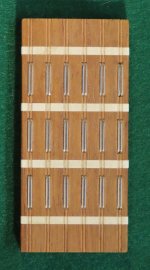
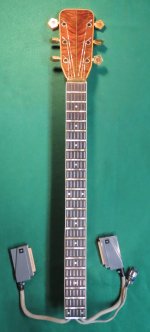
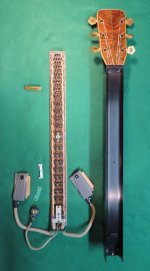

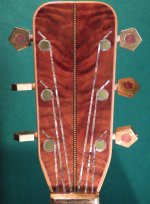
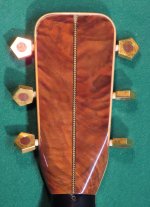

I have been fascinated by the Guitar since I was a teenager.
Many years later, when I was an employee at Scully Recording Instruments Co, Inc. , a fellow employee and I had a discussion about guitars, when he brought up the possibility of a stringless electronic guitar. At that time neither one of us had any idea as to how to construct such an instrument.
Soon thereafter I visited the US patent office in Washington, DC and to my surprise found quite a number of patents of just such instruments. As none of them appealed to me, I set out to design my own version of a stringless electronic Guitar. I did not know enough about electronics to design my own music producing electronic circuits and decided to purchase the music producing circuit boards of a Schober Theater Organ in kit form. The intent was to house the organ components in an external transportable console as they would never fit into the body of a guitar.
The next step was to design the circuitry that would go into the body of the guitar itself. I knew, that would require a very large guitar body and the largest guitar I was aware of in the mid seventies was the large 12-string Guild model that John Denver played. So, I purchased a guitar case for that model and reverse engineered the body and neck dimensions from it.
Then I realized that, I needed some form of touch sensitive switch for the fingerboard and one of my colleagues at Scully's suggested that I could turn a transistor on and off by connecting a power source to the base of a transistor with my finger. That worked. I then created a fingerboard that incorporated 24 touch switches, two octaves. Then I decided to make the fret spacing a uniform .800 inches with strips of abalone inlayed where the frets would have been. I also made the sides of the neck / fingerboard parallel to each other as a tapered neck / fingerboard is only needed as the frets get closer together near to the body of the guitar. There are 144 (24x6) transistors under the fingerboard.
The guitar was to incorporate an electronic capo, and because being electronic, and it can't be seen, I place 11 red light emitting diodes into the side of the fingerboard to indicate where the capo was located. And since I wanted the guitar to be a switchable right and left hand instrument, I placed another 11 LEDs into the other side of the fingerboard.
I machined the neck of the guitar from a billet of 6061-T6 aluminum on a Bridgeport vertical milling machine. The underside of the neck is shaped like half of an ellipse which I machined with a ball end mill by placing the neck fingerboard side down on the machine table lined up with its X axis. I then draw filed and polished the neck and had it anodized and dyed black.
Finally, when I saw how ugly a guitar neck without a headstock looks, I designed and built a headstock consisting of two book-matched pieces of walnut with maple binding and herring bone inlays front and back. I also inlayed abalone "strings" into the headstock and finally attached some mock tuning machines.
The first picture shows the touch switch test with equally spaced flush "frets"
The two parallel "wires" are connected to the base of a transistor and a source of power (5VDC if I remember correctly)
The second picture shows the complete neck. The two Cannon connectors connect three strings each to the body electronics. These connectors are reversible to turn the instrument from right-hand playable to left-hand playable. The single Amphenol connector connects the LEDs to the body.
The third picture shows the fingerboard removed from the neck and placed upside down. It contains 144 transistors.
The fourth picture shows the back of the neck.
The fifth and sixth pictures show the headstock.
In my next post I will describe the body electronics, the picking switches and the "open" tuning design.
So now it's 4:07AM and I'm going to bed.
Sincerely,
Ralf







Last edited:
This was a brilliant idea for touch. Today, this could be easily extended for more resolution (touch areas) along the board, when appropriate encoding is included on board. For example, 256 positions could be encoded into 8-bits to be read using an interrupt-enabled port on a microcontroller and so on.Then I realized that, I needed some form of touch sensitive switch for the fingerboard and one of my colleagues at Scully's suggested that I could turn a transistor on and off by connecting a power source to the base of a transistor with my finger. That worked. I then created a fingerboard that incorporated 24 touch switches, two octaves.
I'm surprised that you call this thing a "failed attempt" when you could actually have gone commercial by sometime in the 1980s, using SMD components etc. That was really a good time for anything electronic.Then I decided to make the fret spacing a uniform .800 inches with strips of abalone inlayed where the frets would have been. I also made the sides of the neck / fingerboard parallel to each other as a tapered neck / fingerboard is only needed as the frets get closer together near to the body of the guitar. There are 144 (24x6) transistors under the fingerboard.
- Home
- Live Sound
- Instruments and Amps
- My failed attempt to design and build a stringless electronic guitar
